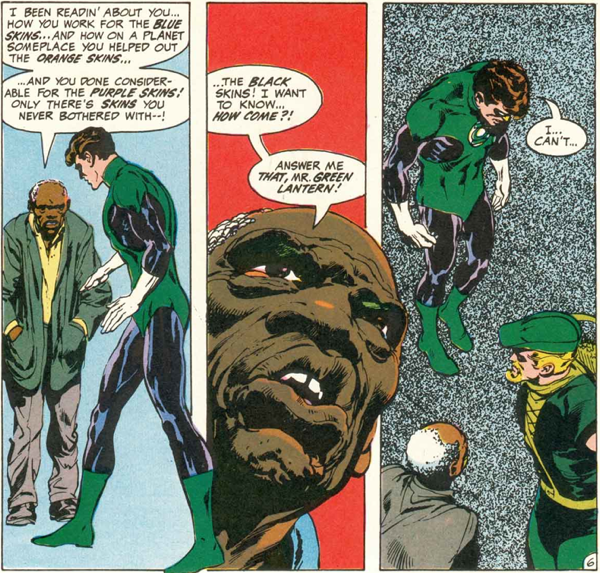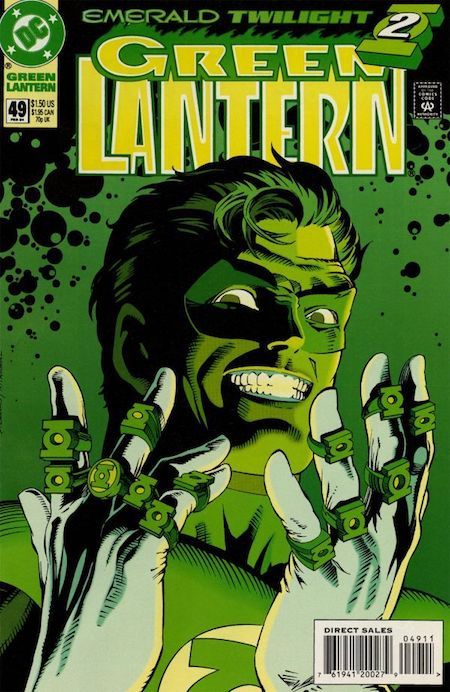
Why Hal Jordan Should Not Be in the Next Green Lantern Movie
A couple weeks ago, a rumor hit the internet that Tom Cruise was in serious talks to play Hal Jordan, the most comics-prominent of DC’s many Green Lanterns. Twitter immediately exploded into jokes, from the idea of Cruise spearheading a superhero franchise when his last attempt to take over a franchise/shared filmic universe—The Mummy—tanked so badly, to the idea of Warner Brothers somehow managing to flounder even harder with the DCEU by taking another swing at Hal Jordan so soon after the disastrous 2011 Ryan Reynolds vehicle. But mostly, and especially, at the idea of centering a franchise with such potential for both weird cosmic adventure and multifaceted inclusiveness, in a post–Wonder Woman, post–Black Panther world, around Harold “Highball” Jordan, The Whitest Man in Space.

Hal’s first appearance, by John Broome and Gil Kane.
To be fair to Warner Brothers, the Screen Rant breakdown linked above does go on to explain that Hal might be in more of a mentor role to rookie Lantern John Stewart, which would explain the casting of 55-year-old Cruise. It also goes a little way towards addressing the fact that thanks to John’s starring role on the beloved and critically lauded 2001 Justice League cartoon (and its 2004 continuation as Justice League Unlimited), he remains the better-known and more popular Lantern among general, non-comics-reading audiences, despite the 2011 movie and a concurrent Green Lantern animated series, both starring Hal.
Still, even if John is a co-lead in the proposed movie—or the primary lead, if they do something like the protege-mentor relationship Paul Rudd and Michael Douglas have in the Ant-Man franchise—this approach to Hal will forever decenter John, or any other POC Lantern they bring in. In part that’s because Tom Cruise is such a big name, with such an outsized “movie star” persona, that he’ll naturally draw all the attention around the project regardless of how much actual screen time he has.
But it’s also because Hal Jordan is just about the whitest character DC has. And he’s that way by design.
Hal Jordan debuted in 1959. Like most of DC’s Silver Age characters, he was privileged along every imaginable axis: white and male, of course, but also straight, cis, able-bodied, Protestant, and descended from an upper class family with significant local political power. (More recent comics have thrown some working class signifiers at Hal, but that doesn’t change the fact that his brother is the district attorney of Coast City, or that they have one uncle who’s a respected judge and another who’s a flat-out millionaire.) Throw in a flashy job like “test pilot” and it kind of feels like gilding the lily to give this guy a magic space ring that can do anything.
What has always struck me most about early Green Lantern comics, though, is how reactionary and conservative he is, even for a DC dude in the early ’60s, and how he’s always been presented as being victimized by progressive advances. His comics fairly reek with anxiety over the possibility of leveling the playing field. For example, his long-time love interest, Carol Ferris, is originally unattainable not because she’s more interested in his glamorous alter ego—but because she’s his boss. Her professional success is only ever presented by the comics as an inconvenience for Hal; at no point does he even attempt to be happy for or proud of the woman he ostensibly loves. But then, this is also the guy who calls his supposed “best friend,” Tom Kalmaku, by the racist nickname “Pieface” because of Tom’s round (i.e. Inuit) face, so what can we really expect?

Carol gets a promotion, ruining Hal’s love life, in Showcase #22 by John Broome and Gil Kane.
Hal’s status as the vaguely disapproving and painfully square face of Middle America was solidified in the early ’70s with the seminal Green Lantern/Green Arrow run by Denny O’Neil and Neal Adams. DC, realizing it couldn’t continue to blissfully ignore the counterculture (and looking to perk up flagging sales on Green Lantern), threw the recently radicalized Oliver Queen into Hal’s book, and the two heroes set off to “look for America.” Along the way, they embodied the different viewpoints tearing America apart. Swingin’ liberal Ollie spoke for the counterculture—but also for the working class, the disenfranchised, and the non-white. (And yes, it’s a huge problem that Ollie is literally caping for POC instead of just letting POC speak for themselves—though there’s a major exception to this in the form of John Stewart; stay tuned—but these comics were still the most explicitly anti-racist ones coming out of DC at the time.)
Hal, on the other hand, embodied the conservative viewpoint: the one who didn’t understand protests or marginalized anger, the one who preferred to look away from oppressive power structures rather than dismantle them. These comics remain some of the most definitive in Hal’s nearly six decade history—and with good reason, because they’re excellent. But it means that Hal will always be that guy whose first instinct was to jump to defend his fellow white men, and to fight injustice on other planets while ignoring it on his own.

Hal’s self-centered privilege is called out in Green Lantern #76 by Denny O’Neil and Neal Adams.
Green Lantern/Green Arrow also brought us John Stewart, introduced in 1972 as Hal’s replacement should one be needed, and DC’s first African American superhero. John is introduced to teach Hal a Valuable Lesson About Racism (literally the lesson is “Is John the real racist for pointing out that someone is racist?” and thankfully the answer is no) and then pretty much vanishes until the ’80s, when Hal quits the Green Lantern Corps in a fit of pique and John takes over. Hal is deeply troubled by a black man taking his place, even though he personally trained John to do so. Similarly, as Hal’s economic fortunes fall and Tom Kalmaku’s rise, Hal grows increasingly upset. In one scene, he compares the likelihood of Tom opening a successful string of gas stations to Coast City’s recently elected black mayor, “which nobody thought would happen!” It’s unclear why Hal thinks all minority success falls under the same header of unfortunate implausibilities, but the anxiety roiling under the surface of his comics isn’t hard to parse.

What’s your point, Hal? (From Green Lantern #73 by Mike Friedrich and Gil Kane.)
By the mid-’90s, DC was deep into a trend of phasing out their older heroes and replacing them with hip new legacy characters, often from more marginalized backgrounds. Hal fell victim to this, becoming the super-villain Parallax and slaughtering the bulk of the Green Lantern Corps. His title passed to Kyle Rayner, a gloriously floppy-haired young artist. (FYI, Kyle was introduced as white, but later retconned to be of mixed Mexican and Irish descent.) Green Lantern comics had a legitimately fresh new direction.
Then came H.E.A.T. And comics fandom would never be the same.
What’s H.E.A.T.? Oh, it’s “Hal’s Emerald Attack Team” (later changed to “Hal’s Emerald Action Team” to seem less violent). See, Hal’s death—and, possibly more to the point, his fall from grace—sparked outrage among his diehard fans. Fan anger was nothing new, but these fans were able to meet and egg each other on through the new medium of the internet. They spent money, collected signatures, took out full-page ads in trade publications, and even sent death threats to writers and editors, all in the name of getting Hal’s life and good name restored—and if Kyle kicked the bucket and writer Ron Marz got fired, so much the better. This is an excellent account from someone who lived through those heady days (and H.E.A.T.’s actual website is still up, which makes me want to call the National Historic Landmarks Program).

Honestly, this cover (by Darryl Banks) makes me laugh every time.
H.E.A.T. was a punchline then and they’re even more of a punchline now, but it’s worth noting that in every blog post or interview I found looking back at them, they’re described the same way: Irrational. Violent. Dangerous. Unhinged. The death threats, attempts to get people fired, and histrionic petitions are mentioned frequently. There’s a real alarm in these accounts, and also a repeated sense that something was lost when H.E.A.T. was born, an innocence and a camaraderie that was replaced with bullying and anger and petty one-upmanship. (Which may be the case, but all of these accounts are by white men, and considering that women in comics still face this kind of vicious backlash for, say, writing a comic with a feminist t-shirt on the cover, it does make me think that this was less the inception of the nasty underbelly of comics fandom so much as the first time most white male fans and creators saw it unleashed so baldly.)
At any rate, H.E.A.T. eventually got their way a decade later when Geoff Johns—a self-proclaimed Hal fanboy—brought his hero back in 2004’s Green Lantern: Rebirth. As the series painstakingly explained, Hal hadn’t gone evil, he had been possessed, specifically by a giant yellow fear bug from outer space, and so he wasn’t actually responsible for any of his actions. Obviously. A few waves of those mighty power rings, and all the changes and growth of the past ten years were erased: Kyle and John were booted down the marquee under Hal’s name, Guy Gardner abruptly stopped being an actual space alien, et cetera. Even Hal’s gray temples were retconned away. Reborn Hal is all about swaggering in and punching Batman in the face for no reason, he’s too virile to age!

John looks as dubious about this whole Rebirth thing as I feel. (Cover by Ethan Van Sciver.)
Hal’s return wasn’t the first instance of an older white hero returning from the dead and in the process shunting aside his younger, often non-white successor, reversing the diversification of the ’90s, but thanks to H.E.A.T.’s infamy, he became one of the most noteworthy examples. Oliver Queen replaced Connor Hawke in 2001; Barry Allen replaced Wally West in 2008. In 2011, DC rebooted their entire universe and erased a good 90% of their history, including a large number of those ’80s/’90s legacy heroes: Connor Hawke. Mia Dearden. Wally West. Jennie-Lynn Hayden. Todd Rice. Cassandra Cain. Stephanie Brown. Some of these heroes (and others I haven’t named) are still MIA.
The return of Hal Jordan was a clear sign to people like H.E.A.T. that throwing an absolute fit over a plot development you don’t like will eventually get you what you want. The fact that DC’s top brass—including Geoff Johns, who zipped up through the ranks at DC in the years after GL: Rebirth—seemed to sympathize with this “out with the new, in with the old” mentality didn’t help. And I don’t think it’s at all a coincidence that this movement coalesced around DC’s most white bread and reactionary hero. The specific players may be different (or not, who knows), but you can draw a straight line from H.E.A.T. to the fans who petitioned to have The Last Jedi stricken from Star Wars canon because it had too many Girl Cooties. Now and forever, Hal is That Guy too: the character who inspired and rewarded some of the most entitled nonsense in DC history, as well as the guy who suspects black people’s motivations as a default and resents his girlfriend’s professional success.
This is not the kind of character who should be leading a franchise. These are not the kind of fans who should get a(nother) movie.
Is it Hal’s “fault” that he’s been saddled with H.E.A.T.’s legacy? Of course not: he’s fictional. And as for his bigoted behavior in his early years…well, I may dislike him for it, but the truth is that any character who’s been around six decades is going to have a few abhorrent moments in his past. Plus, not to pull a “Not All Hal Fans” here, but obviously there are many people who enjoy ol’ Highball’s adventures without being raging jackasses about it. Moreover, all of this inside baseball character semiotics is clearly going to be lost on general audiences who don’t read comics and might very well have confused the last Green Lantern movie with Green Hornet, released the same year. (Which, not for nothing, is about a white guy learning to stop being an ass to POC and white women. And is a much better movie. Ahem.)

A fed-up John and a false equivalent-y Hal in Green Lantern #87 by O’Neil and Adams.
But the choices a studio makes about which heroes to throw millions of dollars behind matter. The choice to dig into DC’s incredibly vast bag of tricks and pull out the whitest guy they can find matters, even if larger audiences won’t grasp the depth of that whiteness. Not having read Green Lantern/Green Arrow doesn’t preclude anyone from looking at Black Panther’s success, Green Lantern’s prior cinematic failure, and John Stewart’s popularity among Millennials and drawing their own conclusions about DC and Warner Brothers’ priorities. And those conclusions won’t be flattering.
As a franchise, Green Lantern has John Stewart. It has Kyle Rayner. It has Simon Baz and Jessica Cruz. (And yes, it has Guy Gardner, but even though he’s my favorite, I strongly believe he works best in a supporting role.) Without even getting into alternate universes and aliens, that’s four potential protagonists who represent the interests, values, and demographics of the kind of growing youthful audience that, you know, goes to see superhero movies.

Better Green Lanterns. Cover by Robson Rocha.
Casting Tom Cruise is such a bizarre choice that it seems like a weird joke, but casting anyone to play Hal Jordan is a mistake. In the niche market of comics, if we must put up with his swaggering blandness, so be it. But if DC/WB wants to improve their cinematic universe’s profile and prove that Wonder Woman wasn’t a fluke, they need to move away from the kind of exclusionary backwards thinking Hal represents.
Hal Jordan is the past. I’m ready for DC’s next space movie to show me the future.









